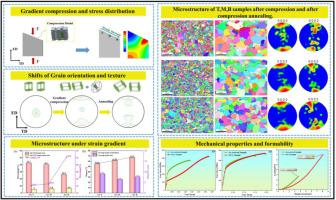基于梯度应变路径的AZ31镁合金板材强塑性协同取向设计
IF 13.8
1区 材料科学
Q1 METALLURGY & METALLURGICAL ENGINEERING
引用次数: 0
摘要
镁(Mg)合金的室温延展性从根本上受到优先基底滑移激活的限制,这一挑战可以通过战略性的晶粒取向定制直接解决。在本研究中,通过25°倾斜的模具,利用梯度压缩应变路径来定制AZ31片的晶体结构。精确控制的变形引起三轴应力状态,将基取向晶粒旋转成梯度{10-12}双晶主导构型,同时产生梯度几何上必要的位错(GNDs)。这种微观结构的二元性协同激活锥体< c + a >滑移系统,并触发异质变形诱导(HDI)强化机制,施密德因子(SF)从0.12升高到0.38。工程板材的极限抗拉强度(UTS)为422 MPa,伸长率(EL)为32.7%,比传统板材分别提高了13%和76%。双介质应变离域可以实现均匀的厚度变形,在室温下达到创纪录的7.7 mm极限圆顶高度。这些结果表明,晶粒取向设计是突破镁固有变形约束的关键途径。本文章由计算机程序翻译,如有差异,请以英文原文为准。

Grain orientation design via gradient strain path for enhanced strength-ductility synergy in AZ31 Magnesium alloy sheets
The room-temperature ductility of magnesium (Mg) alloys is fundamentally limited by preferential basal slip activation—a challenge directly addressable through strategic grain orientation tailoring. In this study, gradient compressive strain paths are utilized through a 25° inclined die to tailor the crystallographic textures of AZ31 sheets. Precisely controlled deformation induces a triaxial stress state that rotates basal-oriented grains into gradient {10–12} twin-dominated configurations, while concurrently generating gradient geometrically necessary dislocations (GNDs). This microstructural duality synergistically activates pyramidal 〈c + a〉 slip systems, demonstrated by Schmid factor (SF) elevation from 0.12 to 0.38, and triggers the hetero-deformation-induced (HDI) strengthening mechanism. The engineered sheets achieve 422 MPa ultimate tensile strength (UTS) with 32.7% elongation (EL), representing 13% and 76% enhancements over conventional counterparts. Twin-mediated strain delocalization enables uniform thickness deformation, culminating in a record 7.7 mm limiting dome height at room temperature. These results indicate that grain orientation design is a critical pathway to transcend magnesium's intrinsic deformation constraints.
求助全文
通过发布文献求助,成功后即可免费获取论文全文。
去求助
来源期刊

Journal of Magnesium and Alloys
Engineering-Mechanics of Materials
CiteScore
20.20
自引率
14.80%
发文量
52
审稿时长
59 days
期刊介绍:
The Journal of Magnesium and Alloys serves as a global platform for both theoretical and experimental studies in magnesium science and engineering. It welcomes submissions investigating various scientific and engineering factors impacting the metallurgy, processing, microstructure, properties, and applications of magnesium and alloys. The journal covers all aspects of magnesium and alloy research, including raw materials, alloy casting, extrusion and deformation, corrosion and surface treatment, joining and machining, simulation and modeling, microstructure evolution and mechanical properties, new alloy development, magnesium-based composites, bio-materials and energy materials, applications, and recycling.
 求助内容:
求助内容: 应助结果提醒方式:
应助结果提醒方式:


